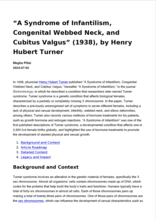Filter my results


Pelvic organ prolapse is a common condition in women that causes the pelvic organs to descend, often resulting from a weakened pelvic floor. Pelvic…
Pelvic PainPelvic FloorPelvisPelvic ExaminationChildbirth
Developmental Effects of Endocrine-Disrupting Chemicals in Wildlife and Humans, was published in 1993 in Environmental Health Perspectives. In the…
LiteratureEndocrine disrupting chemicalsEmbryologyfetal developmentendocrine disruptors
Diethylstilbestrol (DES) is an artificially created hormone first synthesized in the late 1930s. Doctors widely prescribed DES first to pregnant…
DiethylstilbestrolDiethylstilbestrol--Side effectsDiethylstilbestrol--CarcinogenicityPregnancyEstrogen
In 2014, the United States Food and Drug Administration published the Pregnancy and Lactation Labeling Rule to amend previous guidelines for the…
LawDrugs--LabelingDrugs--Labeling--Law and legislationTeratogenic agentsFetus--Effect of drugs on
Beatrice Mintz is a brilliant researcher who has developed techniques essential for many aspects of research on mouse development. She produced the…
PeopleBiographyMiceCancer
In 1901, physician William Henry Walling published the article, Some of the Uses of Electricity in Gynecology, in the January issue of the American…
LiteratureElectricity in medicineGynecologyElectrotherapeuticsElectrotherapy
In 1938, physician Henry Hubert Turner published “A Syndrome of Infantilism, Congenital Webbed Neck, and Cubitus Valgus,” hereafter “A Syndrome of…
Turner SyndromeNoonan SyndromeFemale Pseudo-Turner SyndromeInfantilism, GenitalGonadotropin-Releasing Hormone
Zygote intrafallopian transfer (ZIFT) is an assisted reproductive technology (ART) first used in 1986 to help those who are infertile conceive a…
TechnologyZygote Intrafallopian TransferReproductionFertilization
Amenorrhea is considered a type of abnormal menstrual bleeding characterized by the unexpected absence of menstrual bleeding, lasting three months or…
Amenorrhea, PrimaryMenstruation disordersMenstrual CyclePolycystic ovary syndromeBirth Control